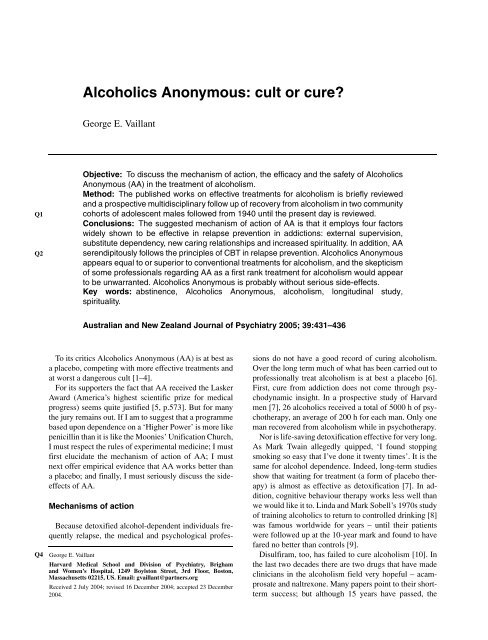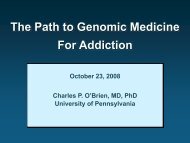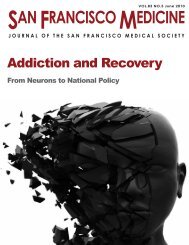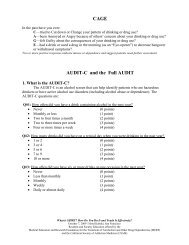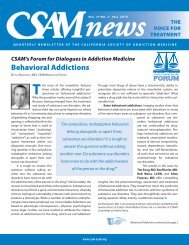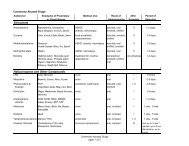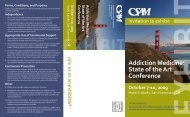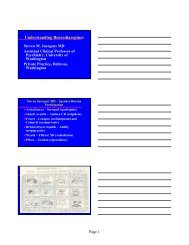Alcoholics Anonymous: cult or cure?
Alcoholics Anonymous: cult or cure?
Alcoholics Anonymous: cult or cure?
Create successful ePaper yourself
Turn your PDF publications into a flip-book with our unique Google optimized e-Paper software.
<strong>Alcoholics</strong> <strong>Anonymous</strong>: <strong>cult</strong> <strong>or</strong> <strong>cure</strong><br />
Ge<strong>or</strong>ge E. Vaillant<br />
Q1<br />
Q2<br />
Objective: To discuss the mechanism of action, the efficacy and the safety of <strong>Alcoholics</strong><br />
<strong>Anonymous</strong> (AA) in the treatment of alcoholism.<br />
Method: The published w<strong>or</strong>ks on effective treatments f<strong>or</strong> alcoholism is briefly reviewed<br />
and a prospective multidisciplinary follow up of recovery from alcoholism in two community<br />
coh<strong>or</strong>ts of adolescent males followed from 1940 until the present day is reviewed.<br />
Conclusions: The suggested mechanism of action of AA is that it employs four fact<strong>or</strong>s<br />
widely shown to be effective in relapse prevention in addictions: external supervision,<br />
substitute dependency, new caring relationships and increased spirituality. In addition, AA<br />
serendipitously follows the principles of CBT in relapse prevention. <strong>Alcoholics</strong> <strong>Anonymous</strong><br />
appears equal to <strong>or</strong> superi<strong>or</strong> to conventional treatments f<strong>or</strong> alcoholism, and the skepticism<br />
of some professionals regarding AA as a first rank treatment f<strong>or</strong> alcoholism would appear<br />
to be unwarranted. <strong>Alcoholics</strong> <strong>Anonymous</strong> is probably without serious side-effects.<br />
Key w<strong>or</strong>ds: abstinence, <strong>Alcoholics</strong> <strong>Anonymous</strong>, alcoholism, longitudinal study,<br />
spirituality.<br />
Australian and New Zealand Journal of Psychiatry 2005; 39:431–436<br />
Q4<br />
To its critics <strong>Alcoholics</strong> <strong>Anonymous</strong> (AA) is at best as<br />
a placebo, competing with m<strong>or</strong>e effective treatments and<br />
at w<strong>or</strong>st a dangerous <strong>cult</strong> [1–4].<br />
F<strong>or</strong> its supp<strong>or</strong>ters the fact that AA received the Lasker<br />
Award (America’s highest scientific prize f<strong>or</strong> medical<br />
progress) seems quite justified [5, p.573]. But f<strong>or</strong> many<br />
the jury remains out. If I am to suggest that a programme<br />
based upon dependence on a ‘Higher Power’ is m<strong>or</strong>e like<br />
penicillin than it is like the Moonies’ Unification Church,<br />
I must respect the rules of experimental medicine; I must<br />
first elucidate the mechanism of action of AA; I must<br />
next offer empirical evidence that AA w<strong>or</strong>ks better than<br />
a placebo; and finally, I must seriously discuss the sideeffects<br />
of AA.<br />
Mechanisms of action<br />
Because detoxified alcohol-dependent individuals frequently<br />
relapse, the medical and psychological profes-<br />
Ge<strong>or</strong>ge E. Vaillant<br />
Harvard Medical School and Division of Psychiatry, Brigham<br />
and Women’s Hospital, 1249 Boylston Street, 3rd Flo<strong>or</strong>, Boston,<br />
Massachusetts 02215, US. Email: gvaillant@partners.<strong>or</strong>g<br />
Received 2 July 2004; revised 16 December 2004; accepted 23 December<br />
2004.<br />
sions do not have a good rec<strong>or</strong>d of curing alcoholism.<br />
Over the long term much of what has been carried out to<br />
professionally treat alcoholism is at best a placebo [6].<br />
First, <strong>cure</strong> from addiction does not come through psychodynamic<br />
insight. In a prospective study of Harvard<br />
men [7], 26 alcoholics received a total of 5000 h of psychotherapy,<br />
an average of 200 h f<strong>or</strong> each man. Only one<br />
man recovered from alcoholism while in psychotherapy.<br />
N<strong>or</strong> is life-saving detoxification effective f<strong>or</strong> very long.<br />
As Mark Twain allegedly quipped, ‘I found stopping<br />
smoking so easy that I’ve done it twenty times’. It is the<br />
same f<strong>or</strong> alcohol dependence. Indeed, long-term studies<br />
show that waiting f<strong>or</strong> treatment (a f<strong>or</strong>m of placebo therapy)<br />
is almost as effective as detoxification [7]. In addition,<br />
cognitive behaviour therapy w<strong>or</strong>ks less well than<br />
we would like it to. Linda and Mark Sobell’s 1970s study<br />
of training alcoholics to return to controlled drinking [8]<br />
was famous w<strong>or</strong>ldwide f<strong>or</strong> years – until their patients<br />
were followed up at the 10-year mark and found to have<br />
fared no better than controls [9].<br />
Disulfiram, too, has failed to <strong>cure</strong> alcoholism [10]. In<br />
the last two decades there are two drugs that have made<br />
clinicians in the alcoholism field very hopeful – acamprosate<br />
and naltrexone. Many papers point to their sh<strong>or</strong>tterm<br />
success; but although 15 years have passed, the
432 ALCOHOLICS ANONYMOUS<br />
long-term studies that could prove – <strong>or</strong> disprove – the<br />
efficacy of these treatments still remain undone.<br />
The reasons f<strong>or</strong> the failure of professional therapy to<br />
prevent eventual relapse, and thus alter the natural hist<strong>or</strong>y<br />
of alcoholism, are twofold. First, the hold that drug addiction<br />
has on human beings does not rest in our c<strong>or</strong>tex.<br />
The hold of addiction on our minds lies in what has been<br />
called our reptile brain. The hold comes from cellular<br />
changes in midbrain nuclei like the nucleus accumbens<br />
and the superi<strong>or</strong> tegmentum. Eventually, loss of plasticity<br />
of neuronal response in these centres renders abstinence<br />
beyond the reach of willpower, beyond the reach<br />
of conditioning and beyond the reach of psychoanalytic<br />
insight.<br />
The second reason that often life-saving professional<br />
treatment fails to prevent relapse in alcoholism is the<br />
same reason that life-saving hospitalization fails to prevent<br />
relapse in diabetes. Change in clinical course in<br />
both alcoholism and diabetes can only be achieved by relapse<br />
prevention and to quote Lady Macbeth’s physician<br />
‘Therein the patient must minister to herself’.<br />
There are four fact<strong>or</strong>s that are commonly present in<br />
relapse prevention f<strong>or</strong> most addictions, be they smoking,<br />
compulsive eating, opiate addiction, gambling <strong>or</strong> alcoholism<br />
[11,12]. The four fact<strong>or</strong>s that prevent relapse are<br />
external supervision, ritual dependency on a competing<br />
behaviour, new love relationships and deepened spirituality.<br />
Usually, two <strong>or</strong> m<strong>or</strong>e fact<strong>or</strong>s must be present f<strong>or</strong><br />
relapse prevention to occur. The reason that these four<br />
fact<strong>or</strong>s are effective is probably because, unlike most<br />
professional treatments, they do not w<strong>or</strong>k to create temp<strong>or</strong>ary<br />
abstinence <strong>or</strong> reduced drinking. They w<strong>or</strong>k to<br />
effect relapse prevention; and, thus, like regularly selfadministered<br />
insulin in diabetics, they must be used f<strong>or</strong> a<br />
very long time. Elsewhere [7] I have stressed the congruence<br />
of these four fact<strong>or</strong>s with Marlatt’s [13] use<br />
of cognitive behavioural techniques to enhance relapse<br />
prevention.<br />
External supervision appears necessary because in<br />
prospective studies conscious motivation to stop drinking<br />
at admission is not associated with outcome [7]. <strong>Alcoholics</strong><br />
<strong>Anonymous</strong>, like most personal trainers, provides<br />
motivation from without and suggests that clients return<br />
again and again. In AA, members are told to find a spons<strong>or</strong><br />
to telephone and to visit often. They are encouraged<br />
to ‘w<strong>or</strong>k the steps’ and to engage in service. Each of these<br />
activities provides a daily involuntary reminder that alcohol<br />
is an enemy, not a friend. These activities provide<br />
external supervision, <strong>or</strong> in the language of AA ‘keep the<br />
mem<strong>or</strong>y green’. But AA also understands that compuls<strong>or</strong>y<br />
supervision w<strong>or</strong>ks best if it is from choice. We willingly<br />
suffer under the strict rules of our athletic coach,<br />
but we evade prohibitions of which we do not approve.<br />
Second, it is imp<strong>or</strong>tant to find a substitute dependency<br />
<strong>or</strong> a competing behaviour f<strong>or</strong> the addiction. You cannot<br />
easily give up a habit without having something else to<br />
do. F<strong>or</strong> example, disulfiram, often prescribed because<br />
it makes the ingestion of alcohol sickening, fails as a<br />
<strong>cure</strong> because although it takes alcohol away, disulfiram<br />
offers no replacement. Eventually the patient stops the<br />
medicine. However, competing dependencies – f<strong>or</strong> example,<br />
methadone maintenance in heroin abuse – facilitate<br />
relapse prevention because they offer a carrot as well as<br />
a stick. In contrast, imprisonment per se did not reduce<br />
relapse to heroin abuse [12]. F<strong>or</strong> punishment alone does<br />
not alter deeply ingrained habits.<br />
<strong>Alcoholics</strong> <strong>Anonymous</strong> understands what all behaviourists<br />
know and what many doct<strong>or</strong>s and parents<br />
f<strong>or</strong>get: bad habits need substitutes. <strong>Alcoholics</strong> <strong>Anonymous</strong><br />
provides not only supervision, but also a gratifying<br />
schedule of social and service activities in the presence of<br />
supp<strong>or</strong>tive and now-healed alcoholics, especially at times<br />
of high risk, like holidays.<br />
Third, new love relationships are imp<strong>or</strong>tant to recovery.<br />
It seems imp<strong>or</strong>tant f<strong>or</strong> ex-addicts to bond with people<br />
whom they have not hurt in the past and to whom they are<br />
not deeply emotionally in debt. Indeed, it helps f<strong>or</strong> them<br />
to bond with people whom they can actively help [14].<br />
<strong>Alcoholics</strong> <strong>Anonymous</strong> meetings are filled with sober<br />
f<strong>or</strong>mer pub-crawlers with whom to befriend but to whom<br />
one does not owe money. Similarly, an AA spons<strong>or</strong>, analogous<br />
to a new spouse, can promote relapse prevention<br />
better than some long-suffering family member whom<br />
they have t<strong>or</strong>tured f<strong>or</strong> years.<br />
As a speculative aside, since it is doubtful that our<br />
prehist<strong>or</strong>ic ancest<strong>or</strong>s shot dope, the brain circuitry underlying<br />
addiction may have evolved <strong>or</strong>iginally to facilitate<br />
human attachment, social cohesion and spiritual community<br />
[15]. Brain opiates are released during the attachment<br />
behaviours of social grooming and during the social<br />
bonding of mother rat–pup reunions [16,17].<br />
The fourth common feature in recovery from addiction,<br />
the discovery <strong>or</strong> rediscovery of spirituality, isthemost<br />
controversial. Inspirational, altruistic group membership<br />
and belief in a power greater than ‘me’ seems imp<strong>or</strong>tant<br />
to recovery from addiction. In The Varieties of Religious<br />
Experience, William James [18] first articulated<br />
the close relationship between religious conversion and<br />
recovery from intractable alcoholism. As Carl Jung [19]<br />
directed the cofounder of AA, Bill Wilson, ‘Spiritus contra<br />
spiritu’. The universal model that Jerome Frank [20]<br />
describes in his book, Persuasion and Healing, f<strong>or</strong> effective<br />
psychotherapy closely resembles spiritual healing. In<br />
Frank’s model the sanctioned healer should have that status<br />
(e.g. several years of abstinence), be equipped with an<br />
unambiguous conceptual model of the problem (e.g. AA’s
G.E. VAILLANT 433<br />
Big Book) and should create in the patient an expectancy<br />
of <strong>cure</strong>. <strong>Alcoholics</strong> <strong>Anonymous</strong> meetings, after all, are<br />
the only places in the w<strong>or</strong>ld that are densely populated by<br />
alcoholics with stable sobriety. Finally, Frank, reminds<br />
us that in group therapy healing came from caring f<strong>or</strong><br />
each other, not oneself. The Twelfth Step of AA carries<br />
the same message.<br />
But there are other reasons that in the addictions spirituality<br />
is valuable f<strong>or</strong> relapse prevention. First, there is a<br />
critical difference between a healing connection in spiritual<br />
communities and with a hierarchical religious leader<br />
<strong>or</strong> psychotherapist. In medicine and auth<strong>or</strong>itarian religion,<br />
the wise powerful doct<strong>or</strong> <strong>or</strong> priest asks the sick,<br />
sinful <strong>or</strong> unenlightened patients to wallow in dependency<br />
and relive their past angers and losses. In contrast, in AA<br />
and other democratic spiritual communities – the playing<br />
field is level. One of the early Akron drunks, to whom Dr.<br />
Bob and Bill Wilson brought their message of alcoholic<br />
recovery, expressed this reciprocity very well: ‘All the<br />
other people that had talked to me wanted to help me, and<br />
my pride prevented me from listening to them ... But I<br />
felt as if I would be a real stinker if I didn’t listen to a<br />
couple of fellows f<strong>or</strong> a sh<strong>or</strong>t time, if it would <strong>cure</strong> them’<br />
[5, p.185].<br />
Second, spirituality affects our behaviour not through<br />
sweet reason but by its appeal to emotion. Four maj<strong>or</strong><br />
longitudinal studies [21–24] have provided evidence that,<br />
after controlling f<strong>or</strong> variables like prohibition of alcohol<br />
consumption, religious involvement when young reduces<br />
alcohol and cigarette consumption when adult. Religious<br />
prohibition of alcohol use (e.g. M<strong>or</strong>mons in Utah and Islam<br />
in Saudi Arabia) has been remarkably successful. In<br />
contrast, governmental prohibition against alcohol consumption<br />
has been less effective (e.g. prohibition in the<br />
US in the 1920s and in the Soviet Union in the 1990s).<br />
Third, alcoholics, unlike most sinners, are not merely<br />
annoying. <strong>Alcoholics</strong> have often inflicted en<strong>or</strong>mous pain<br />
and injury on others. Thus, when sober, the alcoholic<br />
may experience almost insurmountable guilt from the<br />
t<strong>or</strong>ture that they have inflicted on others. Although a po<strong>or</strong><br />
tranquilizer and a w<strong>or</strong>thless antidepressant, alcohol is<br />
perhaps the most powerful solvent f<strong>or</strong> a guilty conscience<br />
that modern pharmacology has yet devised. Theref<strong>or</strong>e,<br />
absolution from guilt mediated by a ‘power greater than<br />
ourselves’ provides an alternative to alcohol and becomes<br />
an imp<strong>or</strong>tant part of the alcoholic’s healing process.<br />
Finally, spirituality, like human attachment – both mediated<br />
by limbic circuitry and the temp<strong>or</strong>al lobe – may be<br />
a w<strong>or</strong>thy substitute f<strong>or</strong> drugs. In other w<strong>or</strong>ds, spirituality<br />
and religion provide an alternative to the high produced<br />
by drugs. Religion, Marx’s ‘opiate of the people’ and<br />
Jung’s spiritus, may be an indirect way that we have of<br />
stimulating our limbic brain and its end<strong>or</strong>phins.<br />
Efficacy of <strong>Alcoholics</strong> <strong>Anonymous</strong><br />
Unf<strong>or</strong>tunately, empirical inf<strong>or</strong>mation on the efficacy of<br />
AA is hard to come by. First, as an <strong>or</strong>ganization AA is<br />
uninterested in research. Second, because of ideological<br />
differences and unconscious rivalry, medical researchers<br />
sometimes have diffi<strong>cult</strong>ies in assessing AA without bias.<br />
Finally, in the course of their long and chronic dis<strong>or</strong>der,<br />
alcoholics encounter many different kinds of interventions,<br />
often simultaneously. Theref<strong>or</strong>e, unlike the case<br />
with most f<strong>or</strong>mal drug trials, there is no way that one can<br />
do a truly controlled study. Until recently, it was unclear<br />
whether AA attendance caused abstinence <strong>or</strong> whether<br />
AA attendance was only a manifestation of abstinence<br />
and greater compliance with professional therapy.<br />
The overall evidence, however, that AA w<strong>or</strong>ks as an effective<br />
‘<strong>cure</strong>’ is quite convincing. First, multiple studies<br />
that collectively involved a thousand <strong>or</strong> m<strong>or</strong>e individuals,<br />
suggest that good clinical outcomes are significantly c<strong>or</strong>related<br />
with frequency of AA attendance, with having a<br />
spons<strong>or</strong>, with engaging in a Twelve-Step w<strong>or</strong>k and with<br />
chairing meetings [25].<br />
Second, f<strong>or</strong> 35 years I have been direct<strong>or</strong> of the Study<br />
of Adult Development. This community study has followed<br />
two coh<strong>or</strong>ts of men, 268 college men and 456 socially<br />
disadvantaged Inner-City men, f<strong>or</strong> 60 years [7,26].<br />
As Table 1 illustrates, about half the sample in both coh<strong>or</strong>ts<br />
abused alcohol until their deaths <strong>or</strong> until the present.<br />
There were few clear prem<strong>or</strong>bid differences that distinguished<br />
the men who achieved stable abstinence from<br />
those who remained chronically alcoholic. Po<strong>or</strong> education,<br />
low IQ and multiproblem family membership did<br />
not identify the men who would fail to achieve stable<br />
abstinence [26]. N<strong>or</strong> did an abundance of risk fact<strong>or</strong>s<br />
f<strong>or</strong> alcoholism, like alcoholic heredity, hyperactivity in<br />
youth and sociopathic behaviour predict chronicity. Nevertheless,<br />
it was notew<strong>or</strong>thy that the men in the good outcome<br />
groups rep<strong>or</strong>ted attending about 20 times as many<br />
AA meetings as the men in the po<strong>or</strong> outcome groups<br />
(Table 1).<br />
Third, a multimillion-dollar controlled study, Project<br />
Match [27,28], compared the effects of three treatments<br />
upon almost 2000 alcoholic patients and arrived at several<br />
interesting conclusions. Project Match revealed that<br />
during the first year AA alone was as effective as<br />
the two most effective professional alternatives: cognitive<br />
behavioural and motivational enhancement therapies.<br />
Indeed, AA in some respects was superi<strong>or</strong> to<br />
cognitive behavioural therapy. Second, the Match follow<br />
up also showed that regardless of the <strong>or</strong>iginal treatment<br />
arm (cognitive behavioural, motivational, <strong>or</strong> Twelve<br />
Steps) the m<strong>or</strong>e AA meetings attended the better the<br />
outcome.
434 ALCOHOLICS ANONYMOUS<br />
Table 1.<br />
Characteristics of alcoholics at age 70 who either met criteria f<strong>or</strong> stable abstinence <strong>or</strong> lifelong chronicity<br />
College coh<strong>or</strong>t<br />
C<strong>or</strong>e city coh<strong>or</strong>t<br />
Abstinent (n = 9) Chronicity (n = 32) Abstinent (n = 57) Chronicity (n = 44)<br />
Age first alcoholic 34 ± 9 42± 10 28 ± 9 31± 11<br />
Years of abstinence 15 ± 11 1 ± 2 ∗∗∗ 16 ± 11 1 ± 2 ∗∗∗<br />
Years of active alcoholism 20 ± 11 23 ± 10 18 ± 9 22± 10 ∗∗∗<br />
Problem drinking sc<strong>or</strong>e 9 ± 3.0 6 ± 2 ∗∗∗ 9.7 ± 3.8 8.3 ± 3.3 ∗<br />
No. of alcoholic relatives 2.3 ± 1.2 2.3 ± 1.1 2.8 ± 1.0 2.7 ± 1.1<br />
AA meetings 137 ± 155 2 ± 9 ∗∗∗ 143 ± 327 8 ± 30 ∗∗∗<br />
Q5<br />
∗ p < 0.05; ∗∗ p < 0.01; ∗∗∗ p < 0.001; Student’s t-test. Adapted from [26].<br />
Perhaps the most convincing controlled study of the<br />
efficacy of AA came from an 8-year follow up by a behavioural<br />
psychologist, William Miller [29]. The purpose<br />
of Miller’s therapy programme had been to return alcoholics<br />
to safe drinking practices, not to produce abstinence<br />
and certainly not to involve them with AA. In addition,<br />
the patients in his study had been self-selected f<strong>or</strong><br />
motivation to return to controlled drinking, not to achieve<br />
abstinence. Nevertheless, after 8 years most Miller’s good<br />
long-term outcomes were abstinent and not controlled<br />
drinkers. In contrast to a long-term abstinence rate of<br />
20% among the 81 clients who went to less than 100<br />
meetings, 53% of the 13 clients who had subsequently<br />
made m<strong>or</strong>e than 100 visits to AA were eventually stably<br />
abstinent – a statistically significant difference.<br />
Finally, at Stanf<strong>or</strong>d, a collab<strong>or</strong>ative 8-year prospective<br />
study [30,31] undersc<strong>or</strong>ed the value of AA in contrast to<br />
professional treatment. In 8 years, the two outcome goals<br />
of less drinking and m<strong>or</strong>e abstinence were only weakly<br />
related to days of professional inpatient treatment, but<br />
robustly related to AA attendance. In sh<strong>or</strong>t, the effect of<br />
AA did not just rest on compliance with treatment.<br />
Certainly, AA is not a magic bullet f<strong>or</strong> every alcoholic.<br />
In my own follow-up studies, there were a few men who<br />
attended AA f<strong>or</strong> sc<strong>or</strong>es of meetings without improvement.<br />
N<strong>or</strong> is it that professional treatment is ineffective.<br />
Session f<strong>or</strong> session I suspect that alcohol professionals<br />
and AA meetings are equally effective. Rather, the efficacy<br />
of AA is like the use of insulin and digitalis; AA<br />
does not stop once the patient leaves the clinic.<br />
Side-effects<br />
The third ‘scientific’ question I must address is: Even<br />
if AA does <strong>cure</strong> alcoholism, is it safe What are the sideeffects<br />
of AA Certainly, AA has its detract<strong>or</strong>s. Designed<br />
to affect the reptile brain the rhet<strong>or</strong>ic and the emotional<br />
language of the spirituality of AA leads journalists and<br />
social scientists to understandably fear that AA is a religion<br />
<strong>or</strong> <strong>cult</strong> [4,32]. Cults can lead to demagoguery and<br />
exploitation. Religion can lead to exclusion, bigotry and<br />
even war. Individual alcoholics attending incompatible<br />
AA groups <strong>or</strong> allying themselves with unf<strong>or</strong>tunate spons<strong>or</strong>s<br />
sometimes tell h<strong>or</strong>r<strong>or</strong> st<strong>or</strong>ies about the fellowship.<br />
Many of the beliefs that AA members express about alcoholism,<br />
are like the tenets of any faith tradition not based<br />
on science. F<strong>or</strong> example, if men are followed f<strong>or</strong> 30 <strong>or</strong><br />
40 years it is found that alcoholism is not a ‘progressive<br />
disease’.<br />
What makes AA safe is that as an <strong>or</strong>ganization it is not a<br />
religion; and AA has deliberately inc<strong>or</strong>p<strong>or</strong>ated principles<br />
to avoid <strong>cult</strong>ic abuse. Religions like nationalism draw<br />
circles that draw others out. <strong>Alcoholics</strong> <strong>Anonymous</strong> and<br />
internationalism draws circles that draw others in. The<br />
spiritual foundation of AA evolved from the intellectual<br />
experience of three men deeply mistrustful of all <strong>or</strong>ganized<br />
religions. These three men, William James with his<br />
Varieties of Religious Experience, Carl Jung with his prescription<br />
‘Spiritus contra spiritum’ and Dr. Robert Smith,<br />
cofounder of AA, were each devout students of what was<br />
truly healing among all religions. Such spirituality, I believe,<br />
usually leads only to love, tolerance, humility and<br />
awe towards the universe. These are qualities that deepen<br />
human relationships and not dist<strong>or</strong>t them as do <strong>cult</strong>s.<br />
Indeed, AA is not about religion at all. The preface to<br />
<strong>Alcoholics</strong> <strong>Anonymous</strong> flatly states, ‘<strong>Alcoholics</strong> <strong>Anonymous</strong><br />
is not a religious <strong>or</strong>ganization’. The only requirement<br />
f<strong>or</strong> membership is an honest desire to stop drinking.<br />
<strong>Alcoholics</strong> <strong>Anonymous</strong> passes the test of universality<br />
so necessary to distinguish safe spirituality from<br />
potentially divisive religion, namely religious conviction<br />
does not prevent AA membership. Over the last 20 years<br />
AA membership has increased 10-fold in Hindu India, in<br />
Buddhist Japan and in Catholic Spain. Membership has<br />
also risen exponentially in atheistic Russia. Per capita<br />
there are three times as many AA groups in Costa Rica<br />
and El Salvad<strong>or</strong> as in the US [33]. Today, one-third of
G.E. VAILLANT 435<br />
AA members are women and one-quarter are less than 31<br />
years old. Research has failed to identify clear personality<br />
differences between alcoholics who do and do not attend<br />
AA [4]. Neither social class n<strong>or</strong> education, neither extroversion<br />
n<strong>or</strong> mental health distinguishes those who use<br />
AA from those who do not. The only consistent variable<br />
that distinguishes AA members from alcoholics who only<br />
attend professional treatment centres is that AA members<br />
tend to have had m<strong>or</strong>e symptoms of alcoholism.<br />
It is w<strong>or</strong>th noting, however, some of the specific ways<br />
that AA has avoided becoming a <strong>cult</strong>. First, from the<br />
beginning, AA has made no clear distinction between<br />
God and ‘the fellowship of AA’. There has always been<br />
a tacit, if not explicit, permission to replace the concept<br />
of God, with the ‘home group’.<br />
Second, the spirituality of AA does not compete with<br />
medicine. <strong>Alcoholics</strong> <strong>Anonymous</strong> published w<strong>or</strong>k is very<br />
clear that it is ‘wrong to deprive any alcoholic of medication<br />
which can alleviate <strong>or</strong> control other disabling physical<br />
and/<strong>or</strong> emotional problems’ and that ‘no AA member<br />
plays doct<strong>or</strong>’ [34, p.11].<br />
Third, some w<strong>or</strong>ry that AA, like <strong>cult</strong>s, exerts mind control<br />
and remove freedom of action. New Y<strong>or</strong>k psychiatrist,<br />
Mark Galanter [35], has defined <strong>cult</strong>s as charismatic<br />
groups ‘characterized by a high level of social cohesion,<br />
an intensely held belief system and a profound influence<br />
on its members’ behavi<strong>or</strong>’ (p.543). As Galanter noted,<br />
this is quite true of AA. But there is an imp<strong>or</strong>tant caveat.<br />
The purpose of AA’s ‘Twelve Steps’, like the rigidity of<br />
post-c<strong>or</strong>onary exercise programmes, is not, as is the case<br />
of <strong>cult</strong>s, to take away autonomy, but only to provide a<br />
disciplined set of ‘suggestions’ so that you won’t relapse<br />
and die.<br />
Finally, a maj<strong>or</strong> difference between all <strong>cult</strong>s and AA<br />
is their governing structure. Cults are characterized by<br />
charismatic leaders with infallible powers and an autocratic<br />
governing structure. In AA ‘Our leaders are trusted<br />
servants; they do not govern’. Most of the AA service<br />
positions are unpaid and all jobs are frequently rotated so<br />
that the consolidation of power cannot occur. The <strong>or</strong>ganizational<br />
chart of AA that has evolved is a pyramid on its<br />
head. Positions of responsibility within AA are defined as<br />
‘service without auth<strong>or</strong>ity’ and the legislative processes<br />
of AA are democratic to a fault.<br />
In AA, but not in <strong>cult</strong>s <strong>or</strong> religion, min<strong>or</strong>ity opinions<br />
are respected. Just as the American Constitution gave<br />
as many senat<strong>or</strong>s to Delaware and Rhode Island as to the<br />
m<strong>or</strong>e populated states of New Y<strong>or</strong>k and Virginia; so AA in<br />
its <strong>or</strong>ganizational deliberations pays particular attention<br />
to min<strong>or</strong>ity opinions.<br />
A criticism of both AA and <strong>cult</strong>s is that they encourage<br />
dependence. And so it is imp<strong>or</strong>tant to distinguish the dependence<br />
engendered by AA from the dependence engendered<br />
by <strong>cult</strong>s. Dependencies can weaken <strong>or</strong> strengthen<br />
us. We are weakened by dependence on cigarettes, slot<br />
machines and junk food. We are strengthened by dependence<br />
on exercise, vitamins and our families.<br />
Finally, AA’s Twelve Traditions reflect founder Bill<br />
Wilson’s 20-year eff<strong>or</strong>t to embrace spirituality and yet<br />
protect AA from becoming a <strong>cult</strong>. <strong>Alcoholics</strong> <strong>Anonymous</strong>,<br />
like the early Christian Church, successfully strives<br />
to stay po<strong>or</strong>. Unlike <strong>cult</strong>s, universities and religious <strong>or</strong>ders,<br />
AA owns no property. <strong>Alcoholics</strong> <strong>Anonymous</strong> traditions<br />
also include personal anonymity in public settings –<br />
a good antidote to <strong>cult</strong>s of personality.<br />
Alcoholism, if not interrupted, is a cunning, baffling<br />
and persistent foe that kills 100 000 Americans a year<br />
[36] – far m<strong>or</strong>e people than are killed by breast cancer.<br />
However, a review of the w<strong>or</strong>ld literature suggests that<br />
professional medicine can do little to halt alcoholism long<br />
term. In contrast, available research suggests that AA is<br />
the most effective means of long-term relapse prevention<br />
in the physicians armamentarium.<br />
References<br />
1. Bufe C. <strong>Alcoholics</strong> <strong>Anonymous</strong>: <strong>cult</strong> <strong>or</strong> <strong>cure</strong> San Francisco:<br />
See Sharp, 1991.<br />
2. <strong>Anonymous</strong> Book Reviewer. <strong>Alcoholics</strong> <strong>Anonymous</strong>. Journal of<br />
Nervous and Mental Dis<strong>or</strong>ders 1940; 92:399–400.<br />
3. Cain AH. <strong>Alcoholics</strong> <strong>Anonymous</strong>: <strong>cult</strong> <strong>or</strong> <strong>cure</strong> Harper’s,<br />
1963:48–52.<br />
4. Shute N. What AA won’t tell you. U.S. News and W<strong>or</strong>ld Rep<strong>or</strong>t,<br />
8 September 1997:55–65.<br />
5. <strong>Alcoholics</strong> <strong>Anonymous</strong>. <strong>Alcoholics</strong> <strong>Anonymous</strong>. 2nd edn. New<br />
Y<strong>or</strong>k: <strong>Alcoholics</strong> <strong>Anonymous</strong> W<strong>or</strong>ld Services, Inc., 1995 (First<br />
edition, 1939).<br />
6. Lindström L. Managing alcoholism. Oxf<strong>or</strong>d, UK: Oxf<strong>or</strong>d<br />
University Press, 1992.<br />
7. Vaillant GE. Natural hist<strong>or</strong>y of alcoholism revisited. Cambridge,<br />
MA: Harvard University Press, 1995.<br />
8. Sobell MB, Sobell LC. Second year treatment outcome of<br />
alcoholics treated by individualized behavi<strong>or</strong> therapy: results.<br />
Behavi<strong>or</strong> Research and Therapy 1976; 14:195–215.<br />
9. Pendery ML, Maltzman IM, West LJ. Controlled drinking by<br />
alcoholics New findings and a reevaluation of a maj<strong>or</strong><br />
affirmative study. Science 1982; 217:169–175.<br />
10. Fuller RK, Roth HP. Disulfiram f<strong>or</strong> the treatment of alcoholism:<br />
an evaluation of 128 men. Annals of Internal Medicine 1979;<br />
90:901–904.<br />
11. Stall R, Biernacki P. Spontaneous remission from the<br />
problematic use of substances: an inductive model derived from<br />
a comparative analysis of the alcohol, opiate, tobacco and<br />
food/obesity literature. International Journal of Addictions<br />
1986; 21:1–23.<br />
12. Vaillant GE. What can long-term follow-up teach us about<br />
relapse and prevention of relapse in addiction British Journal of<br />
Addiction 1988; 83:1147–1157.<br />
13. Marlatt GA, G<strong>or</strong>don JR. Relapse prevention: maintenance<br />
strategies in the treatment of addictive behavi<strong>or</strong>s. NewY<strong>or</strong>k:<br />
Guilf<strong>or</strong>d, 1985.<br />
14. Vaillant GE. A twelve-year follow-up of New Y<strong>or</strong>k narcotic<br />
addicts: IV. Some characteristics and determinants of
436 ALCOHOLICS ANONYMOUS<br />
abstinence. American Journal of Psychiatry 1966;<br />
123:573–584.<br />
15. Insel TR, Young LJ. The neurobiology of attachment. Nature<br />
Reviews/Neuroscience 2001; 2:129–135.<br />
16. Panksepp J, Nelson E, Bekkedal M. Brain systems f<strong>or</strong> the<br />
mediation of social separation-distress and social-reward.<br />
Annals of the New Y<strong>or</strong>k Academy of Science 1997;<br />
807:78–100.<br />
17. Panksepp J, Nelson E, Sivity SM. Brain opiates and<br />
mother–infant bonding motivation. Acta Paediatrica Supplement<br />
1994; 397:40–46.<br />
18. James W. The varieties of religious experience. London:<br />
Longmans Green, 1902.<br />
19. Jung C. Letter to Bill Wilson, 1961 [reprinted in <strong>Alcoholics</strong><br />
<strong>Anonymous</strong> Grapevine, January 1963, pp.30–31].<br />
20. Frank JD. Persuasion and healing: a comparative study of<br />
psychotherapy. Baltim<strong>or</strong>e, MD: Johns Hopkins University Press,<br />
1961.<br />
21. Kendler KS, Gardner CO, Prescott CA. Religion,<br />
psychopathology, and substance use and abuse: a multi-measure,<br />
genetic-epidemiological study. American Journal of Psychiatry<br />
1997; 154:322–329.<br />
22. Koenig HG. The healing power of faith: science expl<strong>or</strong>es<br />
medicine’s last great frontier. New Y<strong>or</strong>k: Simon and Schuster,<br />
1999.<br />
23. Mo<strong>or</strong>e RD, Mead L, Pearson T. Youthful precurs<strong>or</strong>s of alcohol<br />
abuse in physicians. American Journal of Medicine 1990;<br />
88:332–336.<br />
24. Strawbridge WJ, Cohen RD, Shema SJ, Kaplan GH. Frequent<br />
attendance at religious services and m<strong>or</strong>tality over 28 years.<br />
American Journal of Public Health 1997; 87:957–961.<br />
25. Emrick CD, Tonigan JS, Little L. <strong>Alcoholics</strong> <strong>Anonymous</strong>: what<br />
is currently known In: McCready BS, Miller WR, eds.<br />
Research in <strong>Alcoholics</strong> <strong>Anonymous</strong>: opp<strong>or</strong>tunities and<br />
alternatives. Picataway, NJ: Rutgers Center f<strong>or</strong> Alcohol Studies,<br />
1993:41–76.<br />
26. Vaillant GE. A 60-year follow-up of male alcoholism. Addiction<br />
2003; 98:1043–1051.<br />
27. Bab<strong>or</strong> TF, Miller WR, DiClemente C, Longabaugh R, eds.<br />
Comments on Project MATCH: matching alcohol treatments to<br />
client heterogeneity. Addiction 1999; 94:31–69.<br />
28. Longabaugh R, Wirtz PW, Zweben A, Stout RL. Netw<strong>or</strong>k<br />
supp<strong>or</strong>t f<strong>or</strong> drinking, <strong>Alcoholics</strong> <strong>Anonymous</strong> and long-term<br />
matching effects. Addiction 1998; 93:1313–1333.<br />
29. Miller WR, Leckman AL, Delaney HD, Tinkcom M. Long-term<br />
follow-up of behavi<strong>or</strong>al self-control training. Journal of Studies<br />
on Alcohol 1992; 53:249–261.<br />
30. Humphreys K, Moos RH. Reduced substance abuse related<br />
health care costs among voluntary participants in <strong>Alcoholics</strong><br />
<strong>Anonymous</strong>. Journal of Studies on Alcohol 1996; 58:231–238.<br />
31. Timko C, Moos RH, Finney JW, Moos BS, Kaplowitz MS.<br />
Long-term treatment careers and outcomes of previously<br />
untreated alcoholics. Journal Study on Alcohol 1999;<br />
60:437–447.<br />
32. Peele S. The diseasing of America. Lexington, MA: Lexington<br />
Books, 1989.<br />
33. Makela K. Social and <strong>cult</strong>ural preconditions of <strong>Alcoholics</strong><br />
<strong>Anonymous</strong> (AA) and fact<strong>or</strong>s associated with the strength of<br />
AA. British Journal of Addiction 1991; 86:1405–1413.<br />
34. <strong>Alcoholics</strong> <strong>Anonymous</strong>. The AA member medications and other<br />
drugs. New Y<strong>or</strong>k: <strong>Alcoholics</strong> <strong>Anonymous</strong> W<strong>or</strong>ld Services<br />
(Undated pamphlet).<br />
35. Galanter M. Cults and zealous self-help movements: a<br />
psychiatric perspective. American Journal of Psychiatry 1990;<br />
147:543–551.<br />
36. McGinnis JM, Foege WH. Actual causes of death in the United<br />
States. Journal of the American Medical Association 1993;<br />
270:2207–2212.
Queries<br />
Q1 Auth<strong>or</strong>: The subheading ‘Results’ is missing in the abstract.<br />
Q2 Auth<strong>or</strong>: Please define CBT.<br />
Q4 Auth<strong>or</strong>: Please provide auth<strong>or</strong>’s position, f<strong>or</strong> example Clinical Psychologist, Direct<strong>or</strong> of Research etc.<br />
Q5 Au: Please indicate the cross-reference to ( ∗∗ ) in Table 1.


